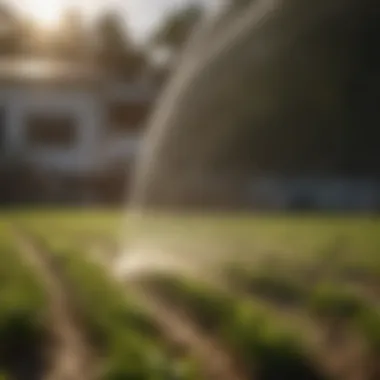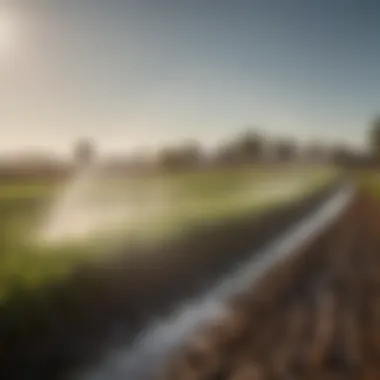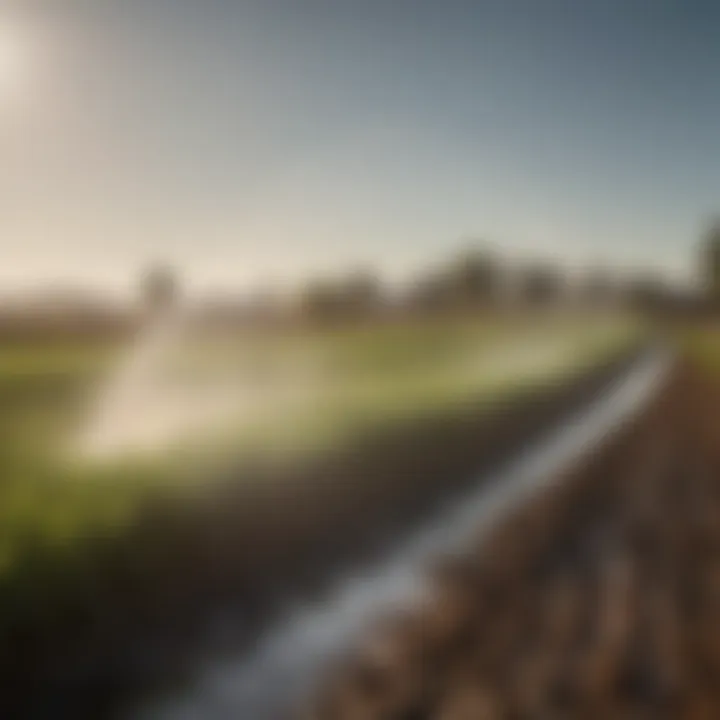Analyzing Agricultural Sprinkler Systems for Optimal Irrigation


Intro
Agricultural sprinkler systems have become a cornerstone in the quest for efficient water management in modern farming. As farmers grapple with the challenges presented by climate change, soil degradation, and increasing crop demands, these irrigation techniques have gained significance. Rather than rely on traditional methods that may waste precious water resources, sprinkler systems offer a more precise solution. They not only aid in enhancing crop yields but also support sustainable farming practices.
In this analysis, we will delve into several aspects of agricultural sprinkler systems, from their foundational concepts to cutting-edge technologies. Understanding these systems is crucial for farmers looking to optimize their irrigation strategies for better productivity and sustainability. Let's get into the nitty-gritty of the topic.
Topic Overview
Definition and Importance
At its core, a sprinkler system is an irrigation method that involves distributing water through a system of pipes and sprinklers across a field. This technology serves to mimic natural rainfall, ensuring that crops receive the necessary hydration in an efficient manner.
The importance of sprinkler systems cannot be overstated. They help in conserving water, reducing labor costs, and increasing the uniformity of water distribution. Moreover, with the right design and management, these systems can enhance the overall health of crops and improve soil conditions.
Brief History and Evolution
The history of sprinkler irrigation dates back to the late 19th century when it began to emerge as a practical method of irrigation in areas with inconsistent rainfall. Early systems utilized simple components such as hoses and gravity-fed water. Over the decades, technological advancements have resulted in the development of sophisticated equipment, including center pivot systems and drip irrigation technology, which allows for targeted watering.
As farming practices evolve, so too do sprinkler systems. Innovations in materials and technology have made them more durable and efficient. Today, farmers have access to smart irrigation solutions that incorporate sensors, IoT devices, and advanced weather data to optimize water use.
Key Techniques and Innovations
Sustainable Farming Practices
Sustainable farming practices are paramount in ensuring the longevity of agricultural ecosystems. Sprinkler systems play a vital role in this regard by promoting water conservation and optimizing resource utilization. Here are a few techniques that enhance their sustainability:
- Soil Moisture Sensors: These tools determine the moisture content of soil and adjust watering schedules accordingly, minimizing waste.
- Variable Rate Irrigation: This method uses technology to apply water where it’s most needed, based on crop requirements.
- Rainwater Harvesting: Integrating rainwater collection systems with sprinkler setups can further reduce reliance on underground water supplies.
Advanced Agronomic Technologies
In the age of technology, innovation is the name of the game. Sprinkler systems have benefited greatly from advanced agronomic technologies:
- Automated Control Systems: These systems allow farmers to control their irrigation remotely, enhancing convenience and efficiency.
- Drones: Used for mapping and monitoring fields, drones help farmers assess the health of crops and make informed decisions about irrigation.
- Data Analytics: Collecting and analyzing data regarding soil conditions, weather patterns, and crop health can guide precise irrigation practices.
Practical Applications
Step-by-Step Guides
When implementing a sprinkler system, it’s essential to follow a structured process. Here’s a straightforward guide:
- Evaluate Field Conditions: Assess soil type, crop type, and existing water sources.
- Choose the System Type: Based on field conditions and crop requirements, decide between fixed, portable, or subsurface systems.
- Design the Layout: Develop a plan that outlines the placement of pipes and sprinklers to ensure even coverage.
- Install and Test: Set up the system according to the design, then conduct tests to check for efficiency and coverage.
- Monitor and Adjust: Regularly review performance and make adjustments as needed based on weather changes or crop growth stages.
Case Studies or Real-World Examples
Real-world applications provide valuable insights into the effectiveness of sprinkler systems. In California, for example, many almond and citrus growers have adopted advanced sprinkler irrigation which allowed them to reduce water usage by 20% while maintaining yield levels. Similarly, farmers in Texas have seen significant improvements in crop yields after implementing variable rate irrigation systems.
"Adopting advanced irrigation techniques is not just an improvement; it's a necessity in today’s competitive agricultural landscape."
As we analyze agricultural sprinkler systems further, we will consider not just their current applications but also the future directions that this essential technology may take.
By diving deeper into design, efficiency, and evolving methodologies, we aim to equip farmers and agricultural enthusiasts with the knowledge necessary to thrive in a complex landscape.
Foreword to Agricultural Sprinkler Systems
Agricultural sprinkler systems serve as a linchpin in modern farming, providing an efficient method for delivering water to crops. With mounting pressure from climate change, unpredictable weather patterns, and an ever-growing global population, optimizing irrigation techniques has become crucial. Sprinkler systems not only minimize water wastage but also enhance crop yields, making them pivotal for farmers aiming for sustainability and profitability.
Water is life for plants; without it, growth stalls and yields dwindle. This reality emphasizes the importance of understanding how sprinkler systems operate, their design intricacies, and their efficient application across varied landscapes. The right system can make or break a farm's productivity. Moreover, with advancements in technology, there are smarter and more efficient options than ever.
In this section, we delve into the essential components that outline the historical context of irrigation practices and provide an overview of modern systems. Through this exploration, we’ll uncover the benefits of these innovations and the considerations that come with them, helping stakeholders align their practices with the pressing demands of sustainable agriculture.
Historical Context of Irrigation Practices
For thousands of years, humans have relied on irrigation as a means to nurture crops and ensure food security. The earliest methods, like canal systems used by the Sumerians or the intricate aqueducts of the Romans, laid the groundwork for effective water management in agriculture. Understanding this historical backdrop is important as it helped shape today’s technologies.
As civilizations advanced, so did irrigation techniques. Traditional methods such as surface irrigation, often dependent on gravity, have gradually transformed to include more sophisticated systems. This evolution not only reflects changes in agricultural practices but also the importance of water conservation. Early practices often lacked efficiency, leading to widespread water loss, which is where modern sprinkler systems can make a significant difference.
Overview of Sprinkler Systems in Modern Agriculture
Today, agricultural sprinkler systems come in various forms and functionalities, each tailored to different farming needs. From overhead sprinklers that mimic rainfall to drip systems delivering water directly to a plant's roots, these methods provide precision that traditional forms couldn't manage.
Some of the notable benefits of modern sprinkler systems include:
- Efficiency: Sprinkler systems can significantly reduce water usage, ensuring that each drop counts.
- Scalability: They can be adapted for both small family farms and large commercial operations.
- Automation: With the rise of smart technology, farmers can control watering schedules and monitor soil moisture levels in real-time.
- Versatility: Different types are available based on the requirements of specific crops and soil types, allowing for tailor-made solutions.
Adopting these systems results in substantial savings—not just in water costs but in time and labor as well. However, farmers must weigh these benefits against the initial setup costs, making informed decisions to maximize both profitability and sustainability. As we dive deeper into the types, components, and impacts of sprinkler systems, the advantages will become even clearer.
Types of Agricultural Sprinkler Systems
Understanding the different types of agricultural sprinkler systems is critical for farmers and agricultural practitioners looking to optimize water usage and improve crop yields. Each system has its own set of mechanisms, advantages, and considerations that can significantly impact efficiency and effectiveness.


Center Pivot Irrigation
Center pivot irrigation is a widely recognized method in modern agriculture. This system typically consists of a long arm that rotates around a central pivot point, delivering water in a circular pattern. It’s like an oversized lawn sprinkler spinning in the field. One of the significant benefits is its efficiency; it covers large areas while minimizing water waste. These systems can manage varying crop heights and types, which makes them adaptable to diverse farming operations. Farmers often appreciate the ease of automation, allowing for scheduled watering without much manual intervention.
"Center pivot irrigation systems can cut water usage by around 30 to 50 percent when compared to traditional flood irrigation methods."
Drip Irrigation Systems
Drip irrigation, on the other hand, has gained popularity in places facing water scarcity. At its core, this method delivers water directly to the plant roots through a series of tubes, minimizing evaporation and runoff. By employing small emitters, the system allows farmers to control the amount of water each plant receives. This system significantly reduces water wastage and is ideal for crops that require consistent moisture. Drip systems can be a bit pricier to install initially, but the savings on water bills and the potential for higher yields often justify the upfront costs.
Spray and Micro-Spray Systems
Next up are spray and micro-spray irrigation systems. These are often used for smaller areas like gardens and flower beds, but they can also extend to larger agricultural fields. Spray systems function by creating droplets of water that are ejected from nozzles, providing a softer watering method that mimics natural rainfall. Micro-spray systems offer a more fine-tuned approach, delivering smaller droplets over a smaller area. One of the benefits here is flexibility; farmers can adjust the nozzle size and water pressure for different plants, making it easier to accommodate various species in a mixed cultivation scenario.
Subsurface Irrigation
Lastly, we have subsurface irrigation, a method that involves installing pipes below the soil surface to deliver water directly to the root zones. This technique helps to reduce evaporation and surface runoff, allowing water to penetrate the soil more effectively. It’s a great option for arid regions where conditions may otherwise degrade soil structure. Additionally, it can promote healthier root systems, as the plants draw moisture from below the surface. Although the initial setup costs can be higher, many farmers are realizing the long-term benefits of investing in this irrigation method.
Key Components of Sprinkler Systems
Understanding the key components of sprinkler systems is crucial for anyone looking to enhance their agricultural practices. Each element plays a pivotal role in ensuring efficient water management, which directly impacts crop yields and sustainability. A well-structured irrigation system minimizes waste and maximizes productivity, offering farmers a reliable means to nourish their crops while conserving resources.
Pumps and Water Sources
Pumps act as the heart of any irrigation system, determining the flow and pressure of water distributed to crops. A pump that fits well with the specific requirements of the sprinkler system can make all the difference in efficiency. For instance, a centrifugal pump is often used for its ability to handle large volumes of water. Alternatively, submersible pumps can be beneficial for deep wells. Understanding the local water source, whether it's a well, river, or reservoir, shapes the selection of the pump and system overall.
The key considerations when choosing pumps include:
- Capacity and Flow Rate: Selecting a pump that aligns with the crop’s water needs ensures sufficient hydration.
- Energy Efficiency: Opting for energy-efficient models helps cut operational costs over time.
- Durability: This aspect becomes critical, especially in zones where equipment faces harsh environments.
It's also vital for farmers to analyze how often water must be replenished and the timing of irrigation to align with crop growth stages. The source of water contributes widely to the overall viability of the irrigation system. An abundant and clean water source creates the backbone for successful operations.
Sprinklers and Their Mechanisms
Sprinklers are the most visible components of any irrigation system. They come in various designs and mechanisms such as impact, stationary, and oscillating. Sprinkler choice should reflect not only the type of crops being grown but also the specific needs of the land.
Key features to keep in mind include:
- Uniformity of Distribution: Ensures that every area of the field receives adequate water.
- Adjustability: Sprinklers that allow adjustments in radius and spray pattern cater to different crops and growth phases.
- Durability and Maintenance: Given they are exposed to the elements, robust materials will minimize maintenance costs.
It's worth noting that even small factors, like wind speed and direction, can influence the effectiveness of a sprinkler. Thus, a proper assessment before system installation helps in choosing the right kind of sprinkler to achieve optimal results.
Control Systems and Automation
In today's tech-savvy world, an irrigation system without some level of automation can be viewed as outdated. Control systems enhance the efficiency of agricultural sprinkler systems by allowing precise adjustments based on real-time data. Advanced systems can monitor environmental variables like temperature and humidity, enabling farmers to irrigate only when necessary.
Features to consider in control systems:
- Telemetry and Remote Monitoring: Many modern systems enable users to control operations from the comfort of their homes or even on the go.
- Data Integration: Connecting irrigation data with weather forecasts can lead to smarter water management decisions.
- Timers and Sensors: Automating when and how long to water saves both time and resources.
The investment in control systems often results in reduced water usage and improved crop health. Farmers should weigh these benefits against the initial costs to evaluate the long-term savings and efficiency gains.
Factors Influencing Efficiency in Sprinkler Systems
Understanding the factors that influence efficiency in sprinkler systems is paramount for anyone involved in agriculture. Efficient irrigation can enhance crop yields and conserve water, making it a critical consideration for farmers and agricultural stakeholders alike. With the ever-pressing need for sustainable farming practices, evaluating these elements presents a pathway toward optimization and effectiveness.
Water Pressure and Flow Rate
Water pressure and flow rate are the lifeblood of any sprinkler system. Think of them as the heartbeat of irrigation; without proper pressure, the entire system could fall flat. The ideal pressure must be consistent, as fluctuations can lead to uneven distribution of water. For instance, high pressure can cause overspray or runoff, while low pressure may result in insufficient coverage.
- Importance of Maintaining Pressure: To maintain a steady water supply, pumps play a key role. A correctly sized pump ensures that water reaches every corner of the field at the desired intensity. Farmers should monitor their systems closely to adjust the pressure as necessary based on varying soil types and climatic conditions.
- Flow Rate Considerations: Complementing the water pressure, the flow rate needs to align with the crop’s needs. Different crops have distinct water requirements, and it’s vital to calibrate the flow accordingly. For say, corn, high flow rates during peak growth can lead to remarkable yields, while beans may thrive with less.
Soil Type and Crop Requirements
Soil plays a critical role in how effective any irrigation system can be. Different soil types—from sandy to clay—exhibit distinct permeability characteristics. They absorb and retain water at varying rates, thus altering how well a sprinkler system can maintain moisture levels.
- Impact of Soil Composition: A sandy soil will drain more quickly than clay, which may hold moisture for a longer period. Farmers should consider conducting soil tests to determine the best irrigation approach. This knowledge can help in deciding whether a sprinkler system should operate for longer periods at lower intensity or shorter bursts with higher intensity.
- Crops and Their Needs: Not all crops drink the same. Some require deep watering while others flourish with more frequent, shallow watering. Hence, aligning sprinkler efficiency with crop needs can make a significant difference in yield.
Environmental Conditions
A sprinkle here and a sprinkle there won’t cut it when environmental conditions come into play. Weather patterns, humidity, and temperature can all impact sprinkler efficiency. Notably, high temperatures can lead to substantial evaporation losses, while strong winds may cause water drift, making precise watering a challenge.
- Weather Monitoring: Farmers should take advantage of modern technology, utilizing tools that provide real-time updates about weather conditions. Access to such data helps determine the optimal timings for irrigation, thus maximizing water use efficiency.
- Long-Term Climate Impacts: Over time, shifts in climate patterns will require re-evaluation of irrigation strategies. Some areas may find themselves facing drier conditions than before, necessitating systems upgrade. Ultra-efficient irrigation solutions can help adapt to these changes, ensuring crops get the moisture they need while conserving resources.
"Water is the most precious resource in agriculture, understanding how to use it efficiently is crucial for sustainable success."
Each of these factors—water pressure, soil conditions, and environmental impacts—converge to shape the operational efficiency of sprinkler systems. As agriculture evolves, paying attention to these elements is essential not just for conserving water, but also for sustaining productivity in increasingly challenging climates.
Economic Considerations of Sprinkler Systems


In the realm of modern agriculture, where competition is fierce and the stakes are high, understanding the financial implications of agricultural sprinkler systems emerges as a crucial aspect for farmers and investors alike. Economic considerations go beyond just the installation of these systems. They encapsulate everything from initial investment to long-term operational costs and, ultimately, the return on investment generated through enhanced crop yields and water savings. A comprehensive grasp of these factors can help producers make informed decisions that positively affect their bottom line.
Initial Investment and Installation Costs
When it comes to setting up an agricultural sprinkler system, the initial investment can be a daunting figure. Factors such as system type, farm size, and specific geographic conditions play a vital role in determining the overall cost. For example, a center pivot irrigation system, known for its efficiency in large fields, might require a hefty investment for both equipment and installation. In contrast, drip irrigation systems, while often lower in upfront costs, may necessitate extensive planning and preparation of the soil.
A typical range for installation costs can vary significantly:
- Center Pivot Systems: These can range from 50,000 to 150,000 dollars, depending on size and specific configurations.
- Drip Systems: Generally, these may range from 10,000 to 30,000 dollars with additional expenses for the delivery of critical resources.
It's imperative not to overlook the hidden costs that can crop up—like land preparation and the need for optimal soil testing—which add significant figures to the initial outlay.
Operational Costs and Maintenance
Once the system is up and running, operational costs become a recurring expense that can dictate long-term profitability. Water usage fees, energy costs for pumps, and periodic maintenance are the primary components of this equation. Properly functioning systems require regular checks to ensure optimal performance, which often leads to increased maintenance expenses.
Moreover, when considering operational costs, one must assess:
- Water Type and Source: The cost of sourcing water, whether from surface or groundwater, can significantly impact the farmer's budget.
- Power Consumption: Sprinkler systems can use a sizable amount of energy, particularly in regions where electricity prices are high.
- Repairs and Upgrades: Over time, systems may require replacing worn-out components, which can incur additional costs.
Strategically planning maintenance can help mitigate some of these expenses, thus allowing farmers to allocate funds more effectively.
Cost-Benefit Analysis of Irrigation Strategies
In the grand scheme, a cost-benefit analysis serves as the compass that guides agricultural operations towards sustainable profitability. This is not merely an exercise in number crunching but a strategic approach that allows farmers to measure the effectiveness of different irrigation strategies. Understanding how much water is saved versus the cost incurred can unveil significant insights.
When evaluating cost against output, several aspects should be considered:
- Increased Crop Yields: Calculating the direct correlation between irrigation efficiency and the yields generated can be a game changer in decision-making. Farms that use advanced systems often report up to a 30% increase in crop production.
- Water Savings: Efficient sprinkler systems can dramatically reduce water waste, potentially leading to lower utility bills which is a factor often underestimated.
- Environmental Incentives: Adoption of modern irrigation practices can also qualify farmers for government subsidies or grants aimed at encouraging sustainable practices.
"The true value in any irrigation infrastructure lies not only in its initial cost but in the holistic assessment of long-term benefits against operational drawbacks."
Environmental Impact of Agricultural Sprinkler Systems
Agricultural sprinkler systems play a crucial role in modern farming, and their environmental impact cannot be overlooked. Understanding this impact is essential for farmers, policymakers, and anyone involved in agriculture. From water conservation to the overall health of the soil and local ecosystems, the design and operation of these irrigation systems have profound implications for sustainability.
Water Conservation and Management
Efficient water management is at the heart of agricultural sustainability. Sprinkler systems, particularly when intelligently designed, can significantly contribute to water conservation. A major benefit of modern sprinkler systems is their ability to minimize water waste by delivering water directly to the root zones of plants. Unlike traditional flood irrigation, which can lead to evaporation and runoff, systems like drip irrigation can provide precise amounts of water, reducing losses.
Water scarcity is becoming a more pressing issue worldwide. According to the United Nations, approximately 2 billion people live in countries experiencing water stress. Consequently, farmers must adapt by using water-efficient systems. This transition to advanced sprinkler technologies can not only conserve water but also improve crop yields, making the most out of limited resources.
"Saving water isn't just about reducing usage; it's about making every drop count in the context of agricultural practices."
To achieve effective water conservation, farmers are encouraged to implement the following strategies:
- Investing in technologies such as soil moisture sensors that can determine when plants actually need water.
- Adjusting sprinkler timings to avoid the hottest parts of the day, preventing unnecessary evaporation.
- Regular maintenance of systems to ensure they function efficiently and do not have leaks.
Influence on Soil Health
The relationship between irrigation practices and soil health is a vital aspect of sustainable agriculture. Proper use of sprinkler systems can enhance soil structure and nutrient availability, promoting healthier crops. Regularly irrigating with sprinklers encourages microbial activity in the soil, which is essential for nutrient breakdown and availability. This is particularly true with drip systems, which can deliver nutrients directly to the root zone, minimizing nutrient leaching and promoting better uptake by plants.
However, poor irrigation practices can have deleterious effects on soil health. Over-irrigation, which sometimes occurs with less efficient systems, can lead to waterlogging. It can displace oxygen in the soil, harming root systems and creating conditions that can promote root rot and other diseases.
Farmers should keep a close eye on their soil's health by:
- Monitoring soil moisture levels to prevent over-irrigation.
- Implementing crop rotation and cover cropping, which enhance soil structure and help maintain fertility alongside irrigation.
- Using mulching to reduce water loss and build organic matter in the soil.
Effects on Local Ecosystems
The effects of agricultural sprinkler systems extend beyond farm borders, impacting local ecosystems. For instance, the introduction of sprinkler systems in previously dry areas can transform local microclimates, affecting flora and fauna. While these changes can sometimes promote biodiversity by introducing new habitats, they can also disrupt existing ecosystems. An influx of water can lead to over-saturation in some areas, which can harm native species adapted to drier conditions.
The strategic placement and management of sprinkler systems must consider the surrounding ecosystem to mitigate negative impacts. This involves:
- Assessing wildlife habitats before installation, ensuring that irrigation practices do not adversely affect local species.
- Employing buffer zones of native vegetation to prevent runoff and provide habitat.
- Monitoring ecological changes over time to adjust practices as necessary.
Technological Innovations in Sprinkler Systems
In today’s fast-paced agricultural landscape, the role of technological innovations in sprinkler systems cannot be overstated. The evolution of these irrigation systems not only enhances efficiency but also ensures sustainable practices that resonate with the pressing demands of modern farming. This section aims to unravel the significance, benefits, and considerations associated with the latest technological advancements in agricultural irrigation.
Smart Irrigation Technologies
The advent of smart irrigation technologies marks a pivotal shift in how farmers manage their water resources. These systems utilize advanced sensors and real-time data to determine when and how much to water crops. The integration of Internet of Things (IoT) devices means that farmers can automate irrigation processes. This not only reduces water waste but also ensures that crops receive the optimal amount of water based on specific needs.
For instance, a farmer using a smart irrigation system can monitor soil moisture levels from their smartphone and adjust watering schedules remotely. This immediacy allows for timely interventions that blur the lines between traditional farming and modern technology.
Additionally, smart technologies can offer predictive analytics, guiding farmers on seasonal weather changes, helping in anticipating droughts or excessive rainfall. The potential reductions in water usage can lead to remarkable cost savings, particularly in regions where water scarcity is a pressing issue.
Sensors and Data Integration


The heart of modern agricultural practices lies in sensors and data integration. These technological components function as the ears and eyes of the farm. Soil moisture sensors, temperature gauges, and weather stations work together to collect vast amounts of data. This data, when analyzed, provides critical insights into the conditions affecting crop health.
To break it down:
- Soil Moisture Sensors: By providing real-time moisture readings, these sensors enable targeted watering, thus conserving water.
- Temperature Sensors: They help predict the best times for irrigation, allowing farmers to align watering strategies with plant growth stages.
- Data Integration Systems: Combining information from various sensors creates a comprehensive view of the field conditions, leading to informed decisions.
An example of this in action is a vineyard utilizing a network of sensors to monitor vine water needs. The data feeds into an integrated system that automates watering based solely on the real-time conditions, minimizing resource waste while maximizing crop yield.
The key takeaway from these advancements is that data-driven decision-making can lead to better resource management, a necessity in today’s resource-scarce world.
Drones and Aerial Irrigation
Drones and aerial irrigation might sound futuristic, yet they are becoming commonplace in modern farming practices. These unmanned aerial vehicles (UAVs) not only provide aerial views of large tracts of farmland but also play an instrumental role in precision irrigation.
Farmers can deploy drones equipped with sophisticated imaging technology to:
- Assess Crop Health: By analyzing vegetation indices, farmers can pinpoint areas suffering from water stress.
- Deliver Water: Some innovative systems even allow for aerial drone spraying of water or nutrients, targeting specific crop zones directly.
- Generate Data Maps: Drones can compile data maps indicating moisture levels across fields, thus informing smarter irrigation decisions.
Utilizing drones can lead to a reduction in labor costs and enhance the accuracy of irrigation practices. In places like vast orchards or extensive vineyards, this technology allows for precise watering practices that traditional methods simply can’t match.
Case Studies of Successful Sprinkler System Implementations
Exploring case studies of successful sprinkler system implementations is akin to peeking behind the curtain to see what really gets farmers ticking. These examples provide precious insights into practical applications of sprinkler technology and the benefits they bring to agricultural practices. They illustrate how diverse projects address unique water challenges and pave the way for better crop yields and resource conservation. Let’s unpack a couple of real-world scenarios that highlight these systems in action.
High-Scale Farming Operations
One excellent example of a high-scale farming operation utilizing advanced sprinkler systems is situated in California, specifically focused on almond orchards. In these vast expanses, farmers have adopted center pivot irrigation systems powered by sophisticated sensors and controls. These systems allow them to manage water distribution efficiently, catering to the specific needs of individual trees.
This means that rather than flooding entire fields with water, these systems tailor the application to areas that require it most. Using data from soil moisture sensors, the system can adjust in real-time—like having a personal assistant for your crops. Not only does this improve water use efficiency by up to 30%, but it also promotes healthier trees as they receive the right amount of water without the danger of over-saturation, which can lead to root rot.
Moreover, the energy costs associated with pumping water are significantly reduced, which helps the farmers keep their operational costs in check. Another study in southern Texas showcased similar implements where large-scale sorghum farming switched to automated drip systems, demonstrating remarkable reductions in water consumption and increased yields.
Sustainable Agricultural Practices
On the sustainability front, look no further than a cluster of organic farms in the Midwest. These operations have opted for micro-spray irrigation, which covers smaller areas of their fields and minimizes waste. By combining this with rainwater harvesting systems, farmers here have struck gold in resource management.
Here’s how it works:
- Water Collection: Rainwater is collected and stored, which is then used in dry spells, providing an extra layer of resilience against droughts.
- Irrigation Control: Micro-spray systems are employed to ensure that water directly reaches plants’ root zones.
- Reduced Runoff: This localized approach significantly cuts down on runoff and evaporation losses, which are common in traditional irrigation setups.
As a result, these farms have reported not only maintaining their yield but also improving social dynamics within their communities by demonstrating that sustainable practices are both feasible and profitable. Plus, they’ve created educational platforms for other local farmers to learn the benefits of these innovative approaches.
In summary, the case studies shed light on the practicality and efficiency of sprinkler systems. They serve as guideposts, encouraging the adoption of these technologies in various agricultural settings.
"Real-world applications of technology in irrigation systems have proven to be game-changers, not just for yields but for the sustainability of our resources."
These examples underscore that every drop counts. Connecting the dots between advanced irrigation and sustainable practices is crucial for a future where agriculture can thrive beautifully while respecting our water resources.
Future Trends in Agricultural Irrigation
The landscape of agricultural irrigation is steadily evolving, driven by innovation and the need for increased efficiency. Understanding future trends in this field is crucial for farmers looking to maximize their yield while minimizing their environmental impact. As water scarcity becomes a pressing issue in many parts of the world, modern irrigation technologies are increasingly essential to address the growing demands of agriculture. This section dives into emerging technologies and policy developments that will shape the future of agricultural irrigation in significant ways.
Emerging Technologies in Farming
Innovative technologies are at the forefront of next-generation agriculture. These advancements not only enhance the efficiency of sprinklers but also improve the way farmers interact with their resources. Here are key aspects of some of these technologies:
- Smart Irrigation Systems: Utilization of sensors and automated controls allows farmers to monitor moisture levels in real-time. This data-driven approach helps optimize watering schedules and reduce waste.
- Drones for Monitoring: Drones equipped with imaging technology can survey large fields quickly, pinpointing areas that need attention. This can guide decisions about where to adjust irrigation efforts.
- AI and Predictive Analytics: Machine learning algorithms that predict weather patterns and soil moisture can aid in planning irrigation. By knowing when to anticipate rain or drought, farmers can effectively manage water resources.
These technologies not only serve to enhance productivity, but they can also mitigate costs associated with excessive water use and energy. Furthermore, they promote sustainable practices that consider the finite nature of water resources in agriculture.
Policy Developments and Their Implications
As technological advancements unfold, formal regulations and policies will likely evolve alongside them. Understanding current and upcoming policies is vital for farmers, as these can have direct implications on their operations. Several considerations merit discussion:
- Water Rights and Resource Management: As water becomes more scarce, policies addressing water rights are essential. Stricter regulations may come into play, impacting how farmers utilize irrigation systems.
- Subsidies for Sustainable Practices: Governments may provide financial incentives for farmers who adopt eco-friendly technologies. Recognizing such programs can facilitate investments in modern irrigation systems.
- Research and Development Support: More stringent policies might push governments to invest in research for better irrigation solutions. Close partnerships between agricultural sectors and policymakers could foster innovations that lead to better water management overall.
"Investment in irrigation technology inevitably leads to a cascading effect, where improved water management begets higher yields and sustainability."
Finale
The conclusion holds a pivotal role in this article, tying together the various threads of discussion regarding agricultural sprinkler systems. As we've navigated through the intricacies of these systems, it's become clear that they are not merely tools for irrigation but vital components of sustainable farming practices. The understanding of their design, functionality, and technological advancements is essential for modern farmers who aim for optimal crop production.
Summary of Key Insights
To reiterate, this article has highlighted several key insights:
- Diversity of Systems: Various types of agricultural sprinkler systems, such as center pivot and drip irrigation, each have distinct advantages tailored to different farming needs.
- Efficiency Factors: Factors influencing efficiency—such as water pressure, soil types, and environmental conditions—are crucial for successful irrigation outcomes. This understanding helps farmers to adjust their methods based on local conditions.
- Economic Impact: The initial costs and ongoing maintenance of sprinkler systems are substantial considerations. Understanding the return on investment is paramount for farmers when evaluating different irrigation strategies.
- Environmental Considerations: Effective water management not only improves crop yield but also contributes to the conservation of vital resources. Sprinkler systems can influence soil health and local ecosystems positively or negatively.
- Technological Innovations: The shift towards smart irrigation technologies promises enhanced efficiency and resource management. Utilizing sensors and data analytics allows farmers to make informed decisions in real time.
Final Thoughts on the Future of Sprinkler Systems
Looking ahead, the future of agricultural sprinkler systems appears bright yet complicated. As technology continues to evolve, we can expect:
- Increased Integration of AI: As artificial intelligence steadily infiltrates agriculture, its potential to optimize sprinkler systems through predictive analytics will change the landscape.
- Regulatory Changes: Policy shifts aimed at sustainable agriculture will likely shape how farmers adopt and implement sprinkler systems, possibly leading to new standards in efficiency and conservation.
- Emerging Technologies: Innovations in materials, efficiency, and automation will play a critical role in making these systems even more effective, reducing water waste and maximizing crop yields.
"Agricultural practices are evolving, and as farmers embrace innovative solutions, the landscape of irrigation will change dramatically. The modernization of sprinklers is not just advantageous; it is essential."
In summary, the topic of sprinkler systems is not just a technical discussion; it encapsulates broader themes touching on sustainability, economic viability, and technological integration. As stakeholders in agriculture move forward, those who keep abreast of these developments will stand to benefit the most from an increasingly efficient and sustainable agricultural sector.



